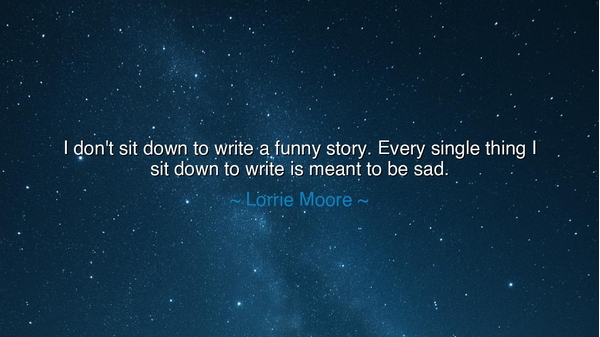
I don't sit down to write a funny story. Every single thing I sit
I don't sit down to write a funny story. Every single thing I sit down to write is meant to be sad.






Hear the solemn words of Lorrie Moore: “I don’t sit down to write a funny story. Every single thing I sit down to write is meant to be sad.” At first, these words may strike the listener with surprise, for Moore is known for her wit, her sharp humor, and the laughter she weaves into her tales. Yet here lies a profound paradox: that within the heart of sadness often resides the seed of laughter, and within humor, the echo of grief. To write with the intention of sorrow is not to reject joy, but to acknowledge that true joy is born only when measured against life’s pain.
The ancients knew this well. Tragedy was the highest form of art in the theaters of Athens. Sadness was not dismissed as weakness, but exalted as truth, for it revealed the fragility of mortal life and the depth of human longing. Yet even in their tragedies, there were moments of irony and wit, for the poets understood that laughter often slips into the cracks of despair. Moore’s confession reflects this eternal tradition: she writes not to chase laughter, but to touch the marrow of sorrow, and yet in doing so she often evokes both.
Consider the story of Abraham Lincoln, a man who bore the crushing weight of war and division. His speeches carried the gravity of death and destiny, yet he was also famed for his humor, his quick wit, his stories that lightened the hearts of those around him. But those who knew him well understood: the humor came not from a heart untouched by sorrow, but from one steeped in it. His jokes were born of grief, his laughter a survival against despair. In the same way, Moore teaches us that what seems light and funny often springs from roots planted deep in sadness.
Why, then, would one choose to write from sadness? Because sorrow is the common thread of humanity. We do not all share the same victories, nor do we all taste the same delights—but every soul has known loss, longing, disappointment, and grief. To write from sadness is to write from the well that all may drink, to touch the universal wound that binds us together. Moore’s words remind us that sorrow is not something to flee from in art, but the very soil from which truth grows.
And yet, the paradox remains: those who write from sadness often give their readers comfort, even laughter. For when sorrow is named and shared, it loses some of its power. It transforms into beauty, into recognition, into a mirror in which the reader sees their own struggles and feels less alone. This is why a story “meant to be sad” may still leave us smiling—it is not the joke itself, but the honesty of the human condition that moves us.
The lesson, then, is this: do not fear your sadness, and do not bury it beneath the false pursuit of endless joy. Bring it forth, give it shape, and let it speak. Whether in writing, in art, or in simple words shared with another, let your sorrows be expressed. For in their expression, they may transform into something healing, even into something that brings light. Humor itself, as Moore reveals, is often the shadow of grief turned into play.
So remember this teaching: sadness is not the enemy of life, but its teacher. Write it, speak it, live through it. Let it inform your joy, sharpen your love, deepen your wisdom. Like the ancient poets, like the leaders and storytellers who bore their griefs yet laughed aloud, you too may learn that the truest stories are born not from the pursuit of amusement, but from the honest well of sorrow. And in naming that sorrow, you may bring to others not despair, but courage, and perhaps even a quiet, enduring smile.






AAdministratorAdministrator
Welcome, honored guests. Please leave a comment, we will respond soon